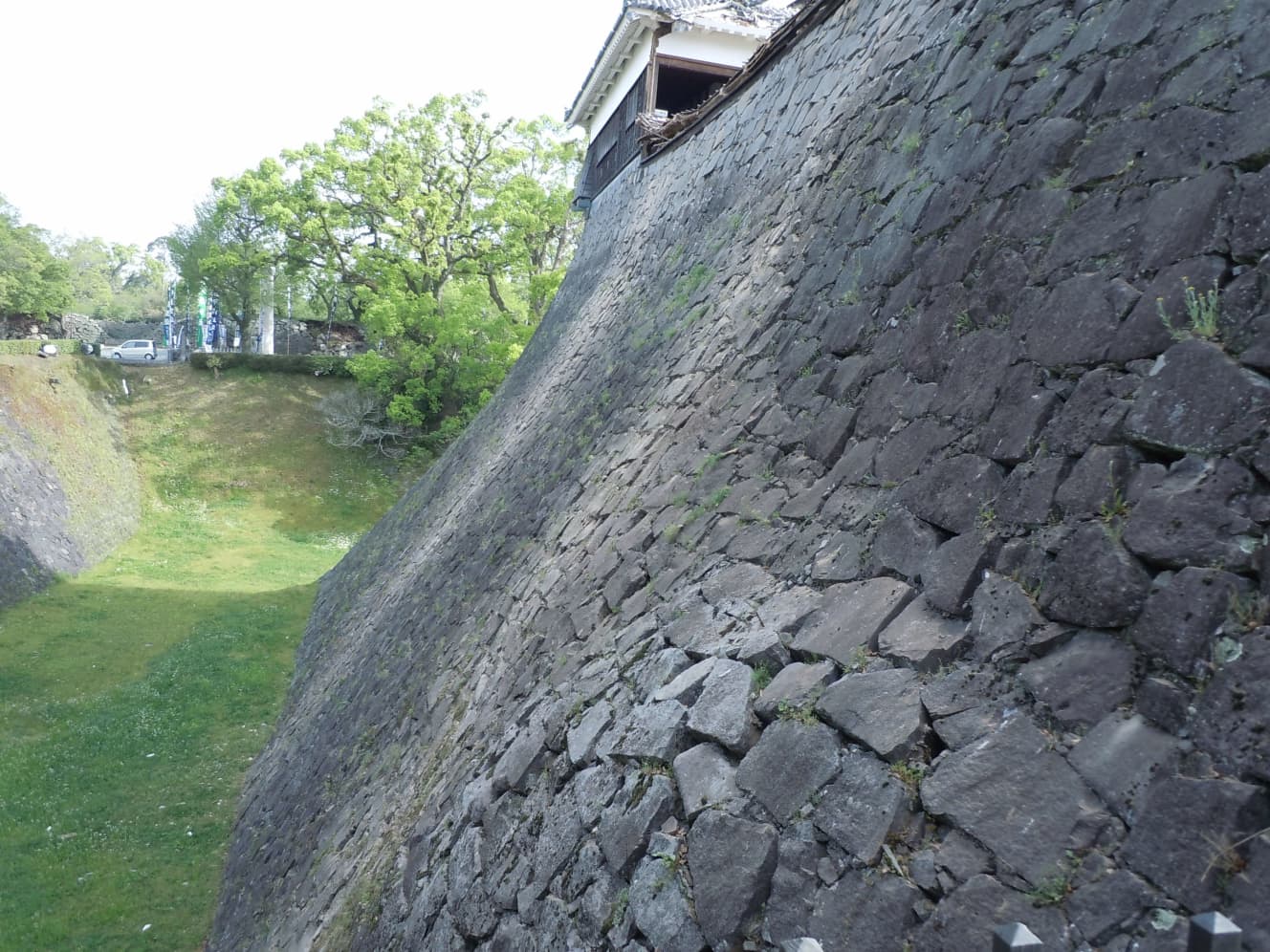On days when only 3-4 stones can be piled up per day… “Kumamoto Castle Restoration Work”: Why is the complete restoration delayed for 15 years & what is the current situation?
Even five years after the disaster, some stonewalls are still undecided on how to restore them. This is the stone wall on which the Udo Yagura (turret) is mounted. This stone wall has a bulging part due to the earthquake.
There is a way to collapse the entire wall and rebuild it, but once it is destroyed, its value as a cultural asset will decrease. Then, can’t we hold down the bulging part and prevent it from collapsing any further? For this purpose, a method called “Habaki Ishigaki,” in which another stone wall is built on the outside of the stone wall, has been used for a long time.
However, the stone wall of Udo Yagura is more than 20 meters long, and to hold it down, the stone wall to be built on the outside would also have to be large. Moreover, in order to stabilize it, it had to be made of concrete. This would make it heavy.
When we drilled a borehole to check the ground, we found that it was weaker than we had expected. If we built a large structure there, it would sink. If we build a havaki stone wall, there is a good chance that it will have a great impact on the existing stone wall.
Therefore, a committee made up of outside academic experts, including experts in cultural properties, civil engineering, and architecture, will conduct technical verification,” said Iwasa.
It is exhausting just to listen to them. If there are still more stonewalls that need this kind of examination, it will not be over in 20 years.
There is an empty moat under the Udo turret. When we conducted an excavation to examine the havaki stone wall, we found that the stone wall of the Udo turret was buried to about 5 meters below the moat. The stone wall itself was built on a foundation of solid ground 5m below, and it was found that the current shape of the moat was formed by sedimentary soil from the Edo period and subsequent fill.
This may have been one of the reasons why the 20-meter high stone wall did not collapse.” (Tateishi)
It is amazing that so many stone walls were piled up by hand in those days, but it is also amazing that they were built with the ground in mind. I wonder if they also did structural calculations in the old days.


Training of “stone masons” for the long term is also needed.
Even so, 35 years is a long time. Can’t we bring in a lot of people and work on several places at the same time?
The way each stone wall collapses is different. Once one is completed, the next may require a completely different approach. I think this difficulty will continue in the future,” said Iwasa.
Even if the same restoration methods could be used, it would be impossible to proceed with several restoration projects at the same time, considering the structure of Kumamoto Castle.
Kumamoto Castle is said to be a difficult castle to attack. It is said that Kumamoto Castle is a difficult castle to attack because there are very few routes into the castle. It is not a castle that can be entered from anywhere. It is not a castle that can be entered from anywhere.
Therefore, if construction is carried out in several places at the same time, it is impossible to enter the castle. The only way to get inside is to start from the back and work one by one. This also makes the restoration work difficult.
The restoration work requires specialists in a variety of fields, including design, surveying, civil engineering, landscaping, masonry, and cultural assets, as well as structural and ground investigation. Kumamoto City is planning to work with businesses and educational institutions to create an environment that will foster the development of masons and other specialists in the local community.
In order to nurture specialists involved in reconstruction, we think it is important to publicize the restoration process of Kumamoto Castle and the appeal of working there so that many people can learn about it.
It may be a steady effort, but having people interested is the first step in developing human resources, and we would like to create an environment where skilled masons and other craftspeople can be nurtured in the region by starting with this kind of effort.
2052…30 years from now…. By then, “I will have exceeded the average life expectancy, so I doubt if I will be able to see the completion of the project,” Mr. Iwasa said with a laugh.
It’s inspiring to see them standing up to something that has collapsed so much. Without a doubt, we are moving toward our goal, and while there is pain, there is also enjoyment.”
Many people have expressed their hopes for the restoration work directly to City Hall, and once again we have been touched by the thoughts of the citizens and residents of Kumamoto Prefecture toward Kumamoto Castle. It is very empowering.” (Mr. Amida)
Interview and text by: Izumi Nakagawa